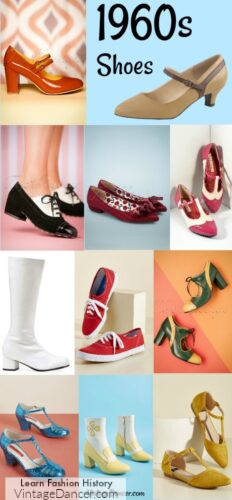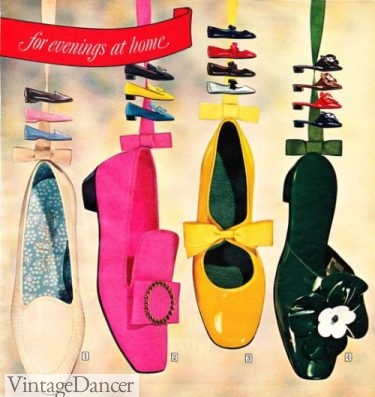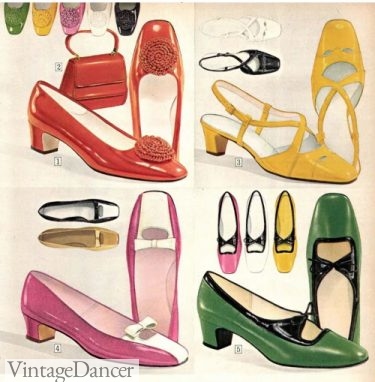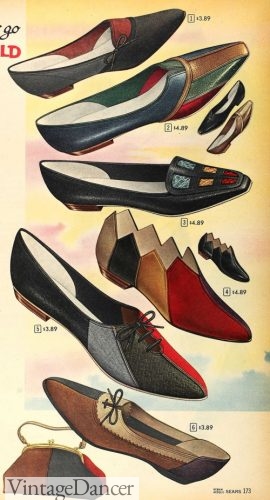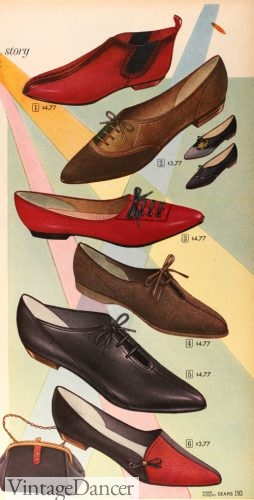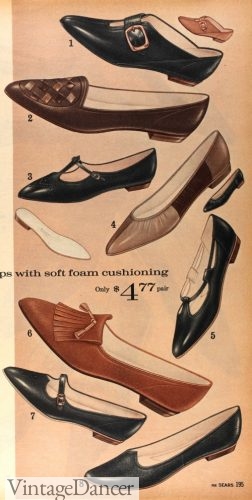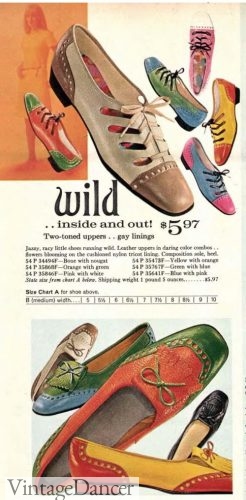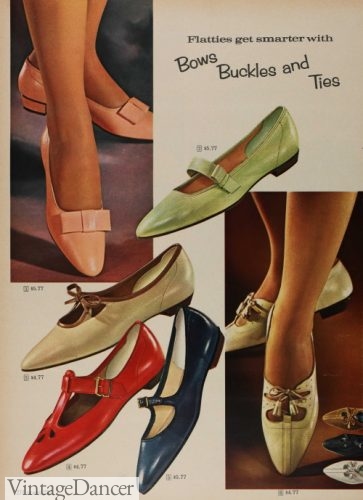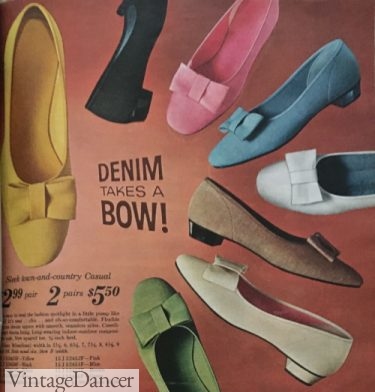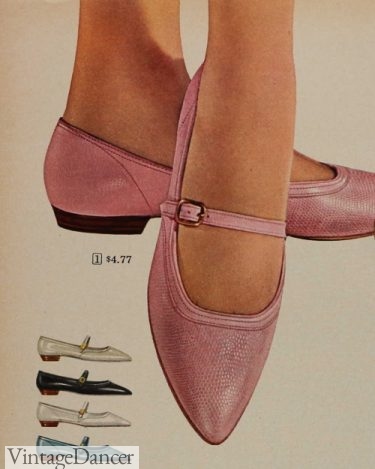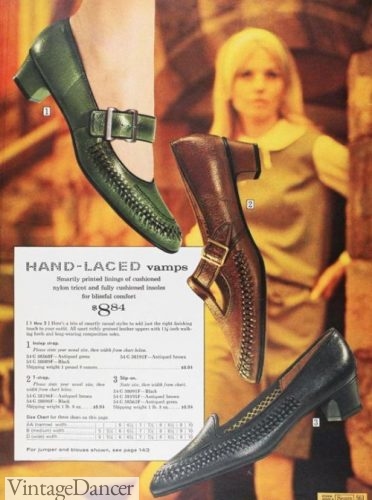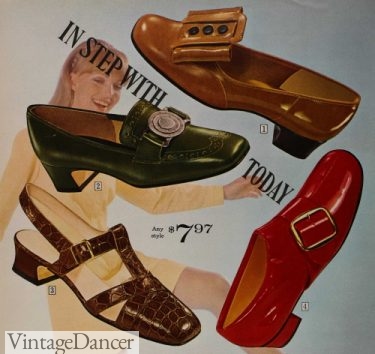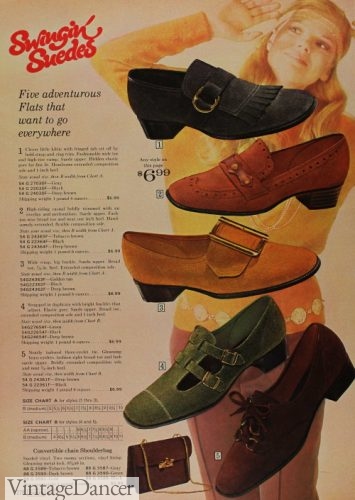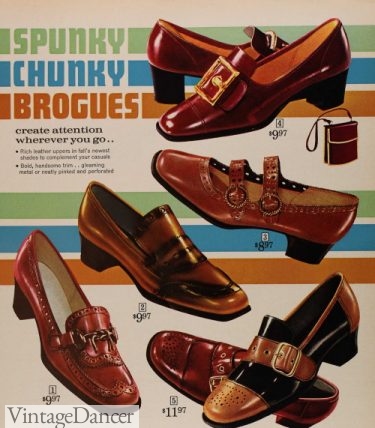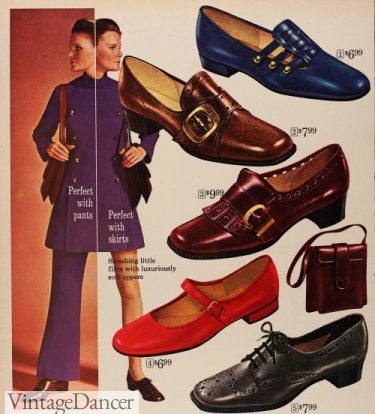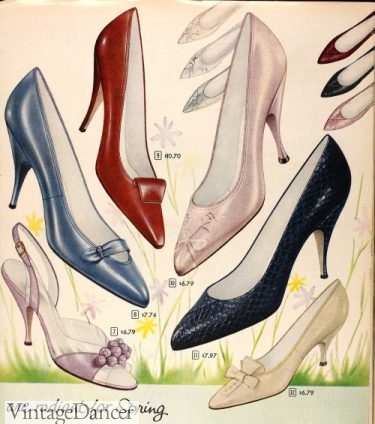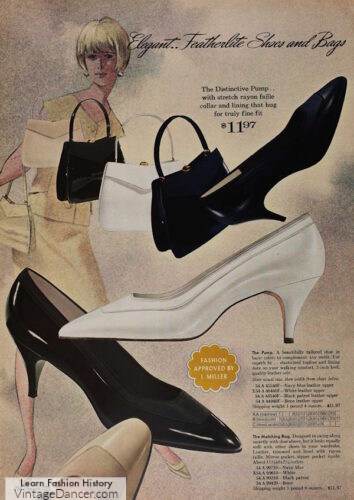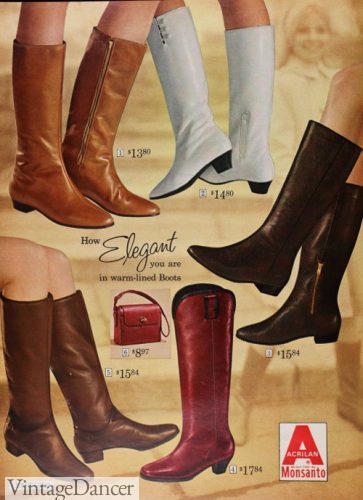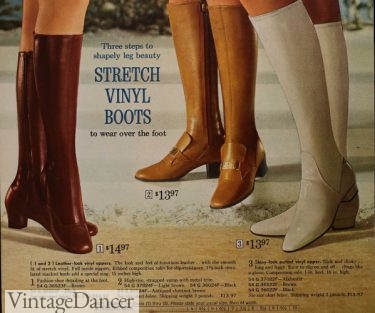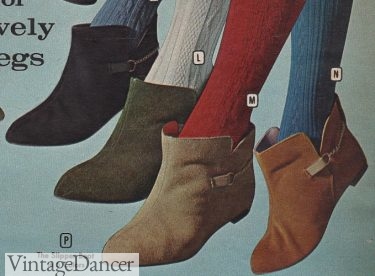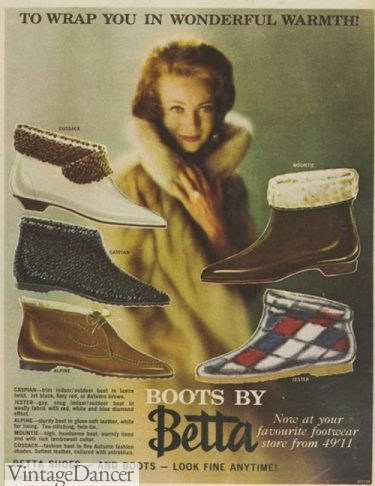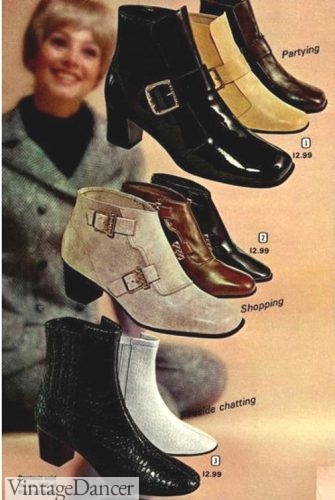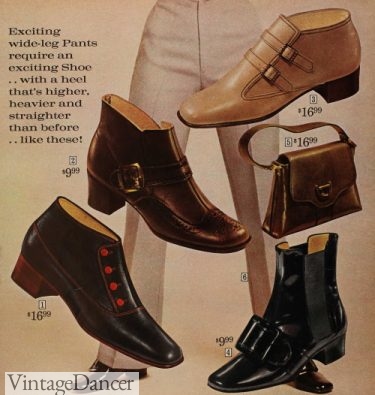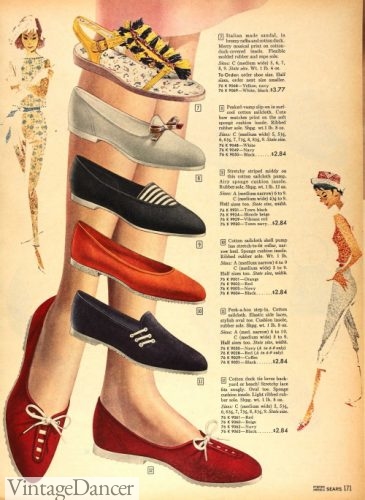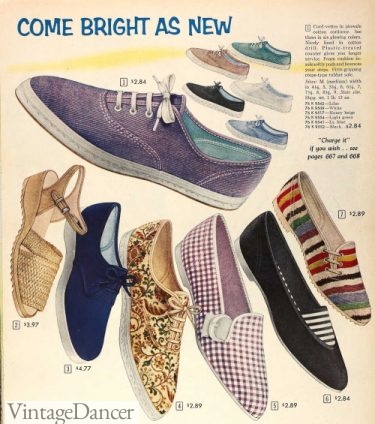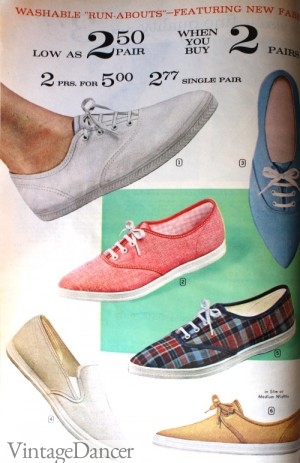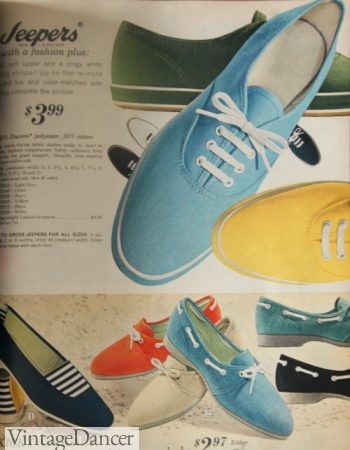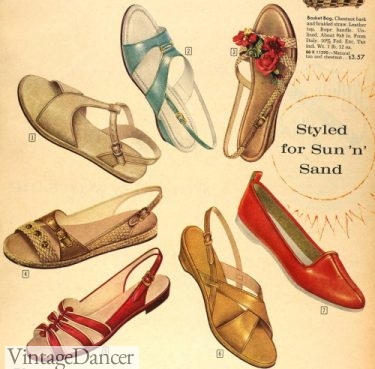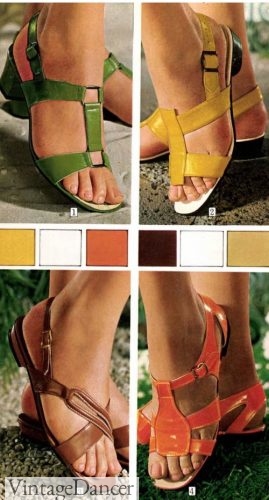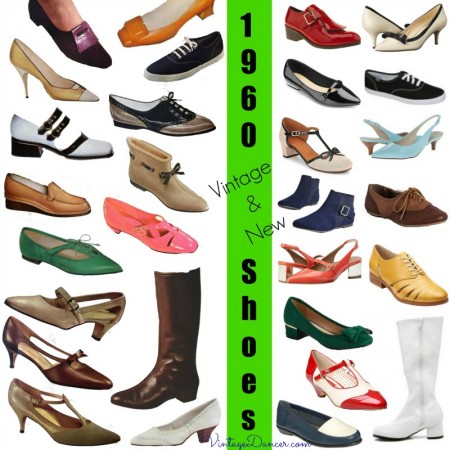
1960s Shoes. Vintage (l) and New (r) 1960s Shoe Styles.
The 1960s, like the 1920s, was a decade for the young — not that one had to be young, just dress in a childish androgynous fashion. Gone were the days of the refined and elegant 1950s woman with her high stiletto heels.
The new generation wanted to be comfortable, free spirited, and cheap! Couture shoe fashion was replaced by street fashion. Expensive materials and long life was snubbed for penny saving throwaway styles that made it possible to own dozens of 1960s shoes for every season. Doesn’t that sound like today’s market?
Skip the 1960s shoe history and shop for 60s style shoes and boots.
1960s Shoe Styles
What were the most popular shoes in the 60s? Petty flats in bright colors, tall stiletto heels, half booties and tall go go boots, classic mary janes, simple sneakers, Birkenstock sandals, and pilgrim shoes plus many more.
- Mod shoes
- 1968 shoes
1960s shoe styles reflected the change in fashion. Instead of big heels, shoes were now flat. Very flat. Many had small square heels and a single Mary Jane strap just like a doll’s shoes.
Flat and low heel shoes were comfortable, easy to wear, easy to live life in. That’s just what every woman wanted in her 1960s clothes.
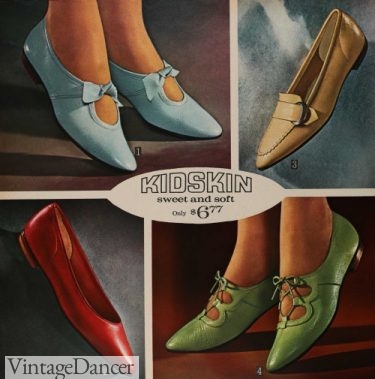
1966 flats
1960s shoes were also cheaper because innovations in new plastics and vinyls made making shoes inexpensive to mass produce. They didn’t last long, but they didn’t need to either.
With new shoe materials came new, brighter colors that matched whatever trendy color was in fashion that season. Baby pink, lime green, deep purple, mustard yellow, orange and sky blue, just to name a few 1960s shoes colors.
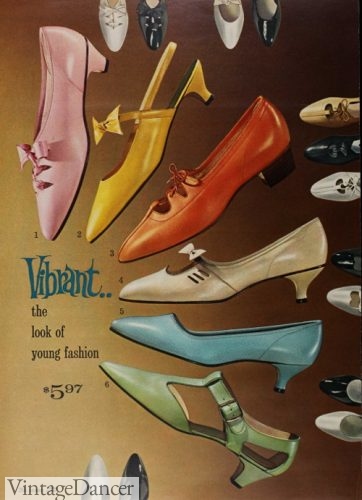
1966 low heels shoes
Two tone color combinations came back in fashion with the mod look. Called spectators they were brown and white, black and white, red and white, blue and white and tan and cream. The two tones were applied to heels and flats equally.
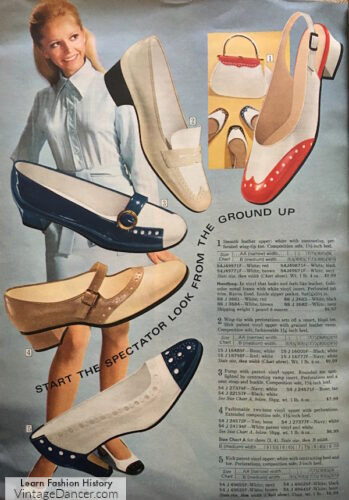
1969 spectator two tone shoes
The 1960s mod style mixed all kids of bold colors together with white or black trim. Most mod shoes were shiny patent leathers and synthetics.
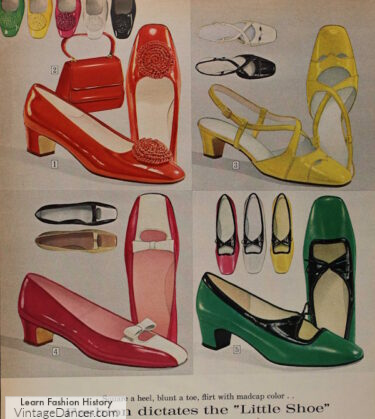
1968 mod colors and two tone combinations
The short skirts and dresses of the ’60s exposed leg — lots of leg — which influenced shoe fashion as well. To keep from accidentally showing her panties, a woman sat with her knees together but feet apart, making her shoes all the more noticeable.
With so much leg exposed and bright colored shoes, women’s 1960s footwear became a focal point rather than an accessory.
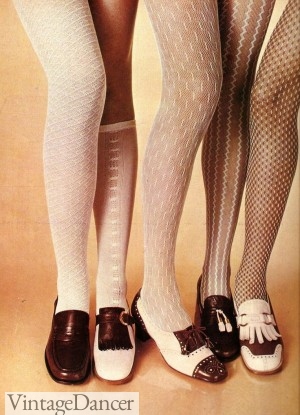
Long legs, funky tights, flat two tone shoes. Very mod indeed!
Besides the general silhouette of flat shoes, there were multiple variations of flats as well as boots in the 1960s. Let us take a look at the most popular shoe styles in the 1960s.
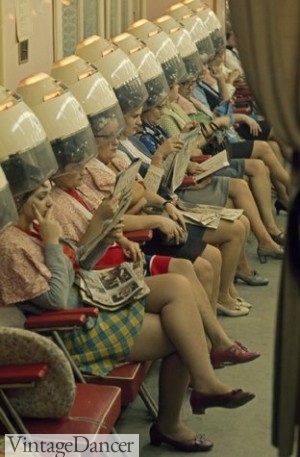
Women at a salon- Notice they all are wearing flat shoes
1960s Pointed Flat Shoes
The late 1950s winklepicker with sharp pointed toe combined with a flat ballet shoe and created the pointy toe flat of the early ’60s. It looked innocent with mini skirts, making them less sexual than when paired with high heels.
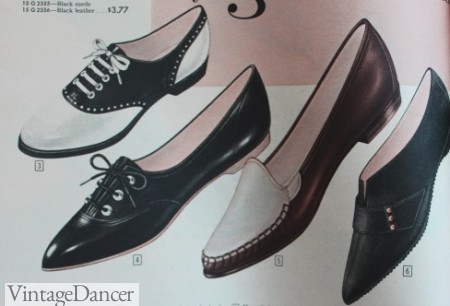
Pointed Toe Flats
The shoe tip extended past the natural toe line so that they no longer pinched a woman’s foot and gave her bunions, ouch! The extra length was a bit awkward to walk in, however.
By the mid ’60s, the toe was reduced to a rounder almond shaped toe to everyone’s relief.
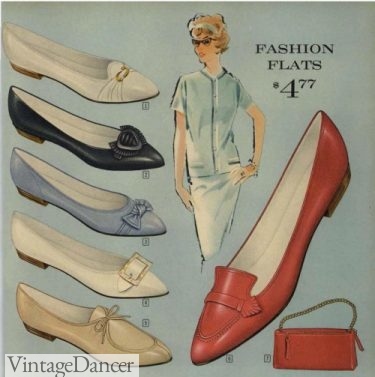
1961 classy pointy toe flats
Flats came in all sorts of designs, including loafers, moccasins, saddle shoes, lace-up Oxfords, single or multi straps, T-straps, monk straps, slingbacks, mules, and wedges.
Basically, if the shoe came in a heeled version before the 1960s, it now was a flat.
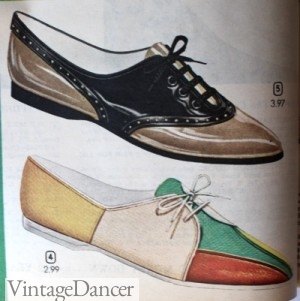
1964 Two Tone Oxford Flats
In my opinion, these ’60s flats are really fun and cute to wear. Maybe without the pointy toes, but to have so many design choices without heels was a good step in footwear history.
- 1962 funky pattern blocking flats
- 1963 simple, casual lace up flats
- 1963 basic flats
- 1968 Wild flats
- 1966 buckled, tied or bow flats
- 1968 Denim bow flats
1960s Casual Shoes
1960s flats could be dressy to casual. The most casual 1960s flat continued to be the loafer shoe. This slip on shoe went through the 60s transformation of less-is-more. Less heel, less width, and less decoration.
Moccasin toes with contrast white stitching as well as the classic penny loafer strap were updated with 60s colors and a much narrower toebox and pointy toe.

1966 basic loafer shoes with moccasin trim (L) and penny loafer (R) styles
Another trendy 60s loafer was the two eyelet tie shoe. Like men’s chukka boots and shoes, the women’s version was minimally designed yet had a touch of the masculine look.
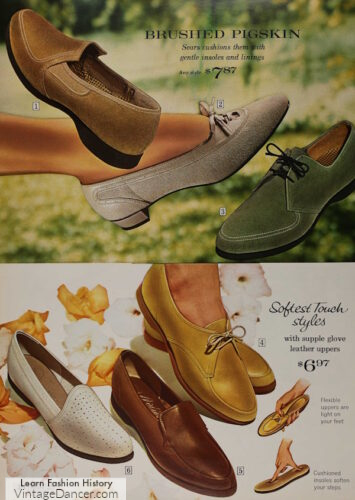
1967 loafers and tie shoes
1960s tie shoes also came in soft brushed suede and thin flexible leather for the ultimate in comfort. Colors remained neutral and earthy-tones to match menswear.
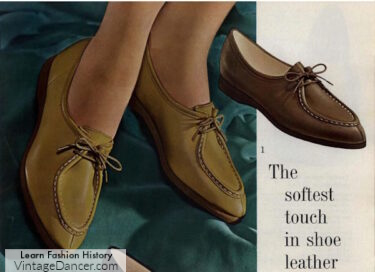
1965 two eyelet tie shoes
1960s Mary Jane Shoes
What was a popular shoe in the 60s? The Mary Jane!
Of all flats and heels in the 1960s, the early years embraced the return of the dancing shoe of the ’20s and ’30s. With a sturdy Cuban heel, shapely body, and thin straps, they made a woman’s legs look like thin dancer’s legs.
The doll face look of the early 1960s made the classic Mary Jane shoes even more popular. With a single strap across the vamp, round toe, and short Cuban heel it was very “cute” and quite comfortable, too. Paired with thick white stockings and an empire top mini dress, the doll look was complete.
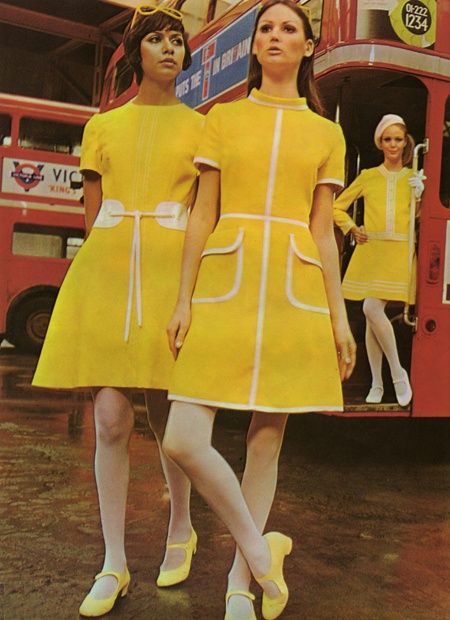
Baby Doll Style with Mary Jane Shoes
The Mary Jane heel height varied from 2-3 inch pumps to low 1/2 to 1.5 flat heels. It was one of the few styles of high heels to remain in fashion for most of the 1960s.
- 1965 pink Mary Jane shoes
- 1969 earth-tone mary jane shoes
1960s Mary Jane shoes came in solid colors as well as two tone combinations. Black shoes accented in white had been on trend for 50 years. Almost any color shoe with white trim was now worn in the 1960s, as well as dark on dark colors (e.g. brown on black).
Straps started out thin in the early years and became wider with heavy buckles by the mid ’60s. There were also tie laces and small bows as alternatives to buckle straps.
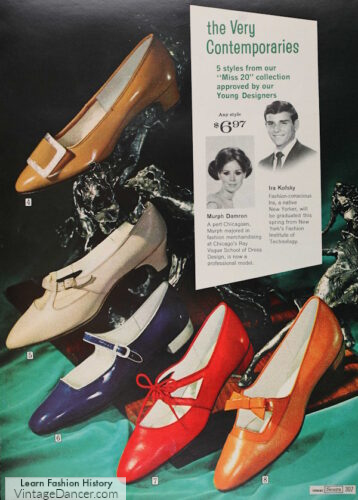
1967 mixed strap mary jane shoes
Multi strap Mary Jane shoes also had a presence in the ’60s. Single and multi strap Mary Janes traditionally came across the arch of the foot, but the mid ’60s style preferred a lower placement closer to the toes.
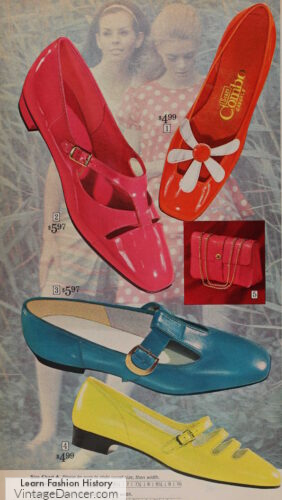
1968 mod color strappy mary jane inspired flats
These made them slip on shoes rather than buckled. The look was there, but the functionality of straps was simply for decoration.
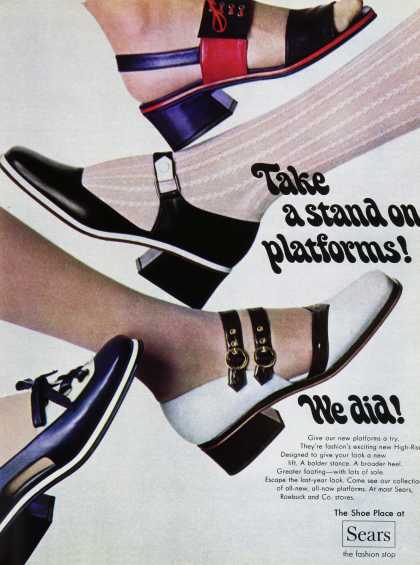
Late 1960s Mary Jane Shoes with a Platform Heel
The T-strap shoe also returned in the 1960s (it actually never left fashion) in the same form as we saw it in the 1920s. It had a mid sized stacked heel with a long almond shaped toe and thin T-straps.
1960s T strap shoes came in for casual wear and higher heels for evenings. Many shoes also had some Deco shapes on the straps for another nod back to the 1920s.
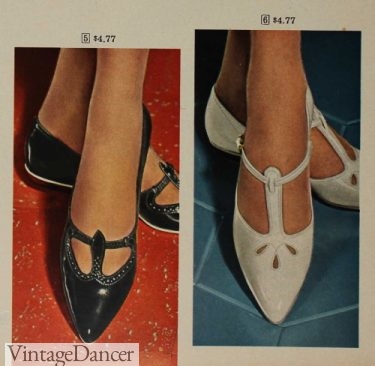
1965 T-strap Shoes
As pictured below, many shoes including pumps, Mary Janes, and T-straps all featured cutouts on the body of the shoe. Some also continued the tradition of having small flat bows or large colonial style embellishments on the vamp.
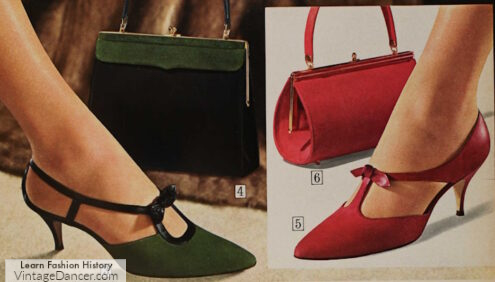
1966 T strap style 60s evening shoe heels
1960s Pilgrim Pumps
Tired of squeezing toes into pointed stiletto pumps and flats, designers welcomed the Pilgrim, or colonial, pump. It had an elongated blunt square toe similar to those worn by women and men in the 17th century.
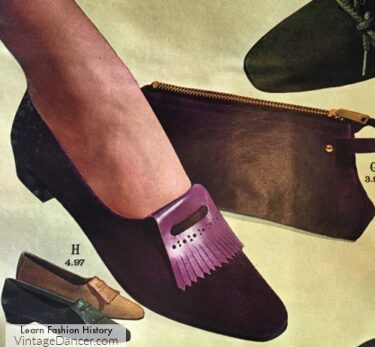
1964 fringe tongue pilgrim shoes
The blunt toe, also called a chisel toe, was introduced in 1960 but didn’t take off until 1965, where it was made even more Pilgrim-like with the addition of large shoe clips, fringe and buckles to the toe box.
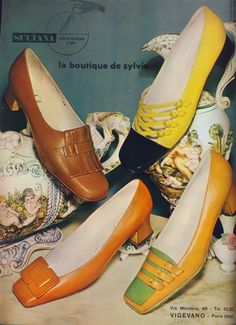
1960s Pilgrim Pumps
Pilgrim Pumps were elegant and sophisticated in their finest form. It was the most copied shoe design of the entire 1960s decade.
1960s shoe designers took the overall Pilgrim look and modified the design into something more casual. Instead of adding bulky shoe buckles, the designers added shapes and patterns onto the toe box that mimicked the look of buckles.
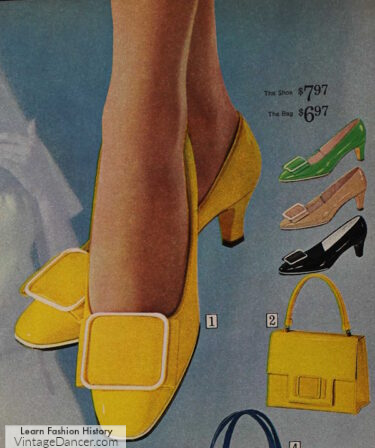
1968 pilgrim buckle shoes
The Union Jack symbol was popular with the swinging youth in London. Other geometric shapes, straps, and tongues added to an overall mod-ish design on footwear for the remainder of the ’60s.
In the late 1960s, the brogue shoe became the latest style of loafer, pilgrim shoe, oxford and mary jane. Brogue were small holes or perforations that decorated the body and straps of oxford leather shoes.
- 1968 funky buckles
- 1969 buckle shoes
Deep rich browns, cherry tones and black set the mood for shoes going into the 1970s. With a sturdy wide heel the platform shoes was almost made.
- 1969 chunky brogue shoes
- 1969 buckles and brogue
1960s Kitten Heel Pumps
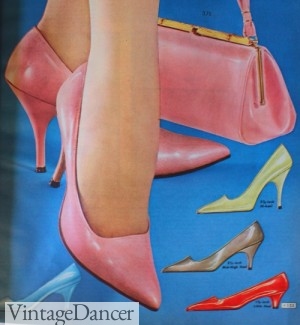
1964- Three heel heights. Tall stiletto and mid and short kitten heels.
Tall, thin heels were no stranger to the 1950s. They shaped the leg and helped women put some wiggle in their walk while wearing a tight pencil dress. The pencil dress continued into the 1960s but with a straighter shift shape — no wiggle required.
Tall heel shoes in the early 1960s were replaced by short kitten heels or Sabrina heels, which were much easier to walk in but still offered some leg shaping and elegance.
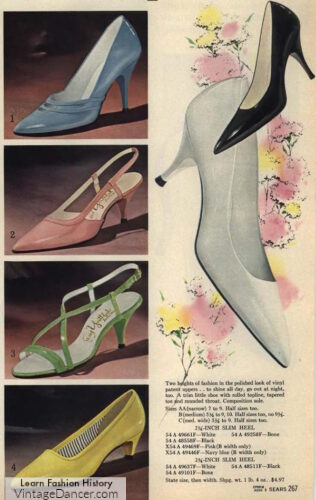
1965 high heeled shoes
The kitten heel pump was popular as a slingback shoe– an open heel and one strap that buckled around the back. They looked especially sharp for evening wear in the 60s.
- 1962 spring tall heels
- 1967 classic black or white heels and purses for evenings
Although tall heels were never high fashion or cutting edge enough for modern designers, real women continued to wear them and department stores continued to sell them until the late 1960s.
In my old catalogs, there are more pages of stiletto shoes for sale than flats and boots. Despite changes in new fashion, women still loved their tall heels.
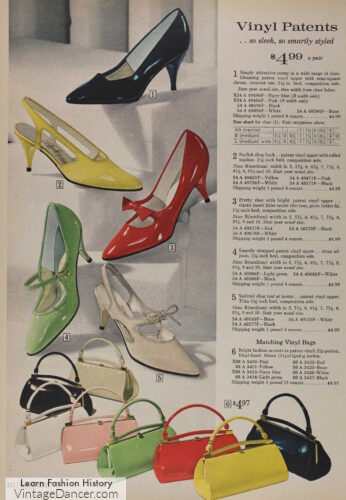
1967 high, pointy heels in bright colors and strap designs
Another type of heel in the 1960s was the stacked heel. These looked like layers of wood stacked on top of each other and shaped into a sturdy Cuban heel. They were less delicate than stiletto heels or even kitten heels, making them great choices for everyday shoes.
The stacked heel shoe grew bigger and taller and eventually became the platform shoe of the late 1960s and 1970s.
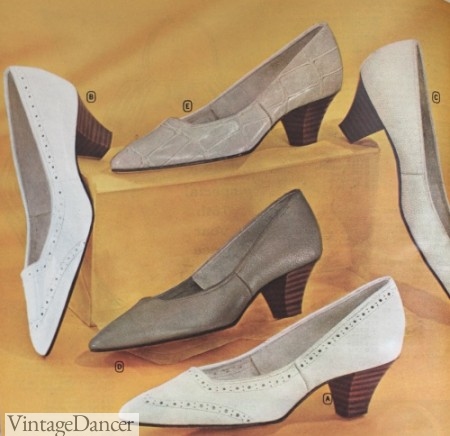
Stacked Heel Pumps
1960s Boots
Did they wear boots in the 60s?
Boots were “too old lady like” in the early ’60s: ankle high, mid heel, and with a zipper pull. They were what women had been wearing in winter for decades and despite being practical, they weren’t particularly fashionable.
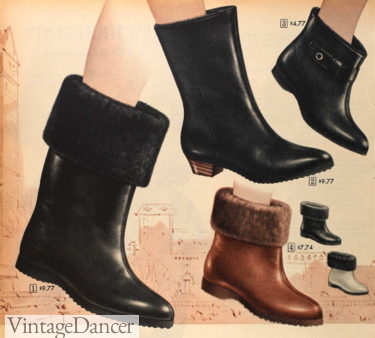
1963 fur cuff winter boots
No modern girl could be seen in those old boots. For the early 60s years, women froze their feet in low flats for the sake of being in fashion. That is, until the fashion boot was reinvented with the help of some modern materials.
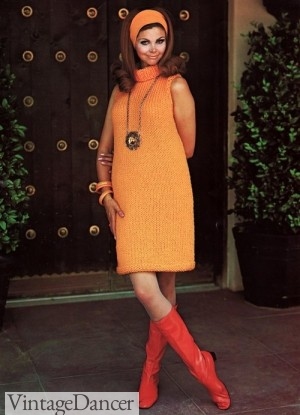
Orange PVC Boots
Because pop art had been influencing fashion with bright primary colors and shiny surfaces, it was only a matter of time before footwear adopted both.
PVC, polyvinyl chloride, was flexible enough to be shaped into shoes yet could be made in any bright shiny color imaginable. It was also waterproof. PVC was used on flats, Mary Janes, pumps, half booties, and tall Go Go boots.
“Tall” boots meant anything above the ankle. Go Go boots became the name for any style of tall boot in the 1960s.
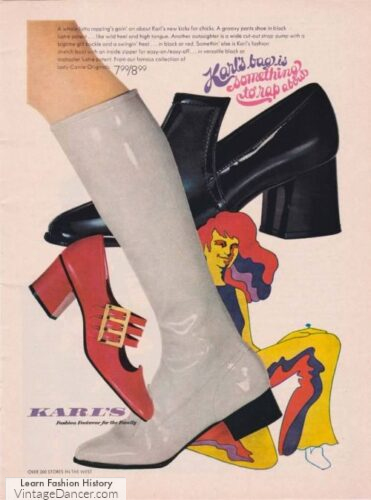
1969 go go boots and platform shoes
1960s boot colors were usually plain. The very mod look of black and white really popped in PVC as did other combinations such as blue and white or green and yellow. PVC did not do well with small details.
The two-tone look was always in big blocks of color. Boots, for example, were half white and half a solid color with a seam down the center.
Modern girls bought two pairs of boots and wore one in each color. The right in blue, the left in orange. Very mod indeed.
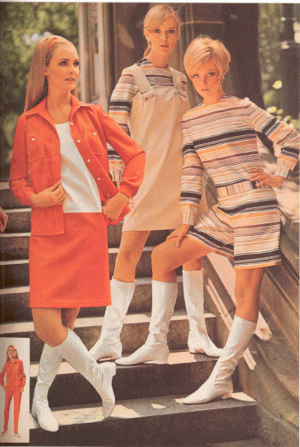
1968 Go Go Boots
Besides pop art, the Space Age obsession with all things futuristic introduced metallic colors to footwear: silver, bronze, alien green, rocket ship red. They looked to be part of something new and unfamiliar, especially on pull on boots with flat soles and pointed toes. Shiny boots were sleek and sexy.
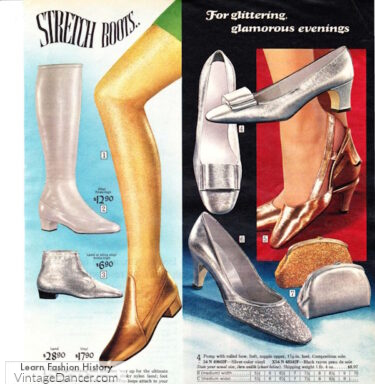
1968 stretch boots and glitter shoes for evenings
Silver and white became the new black. Everyone had a pair of each. In Europe, they were called Courreges boots, named after the designer.
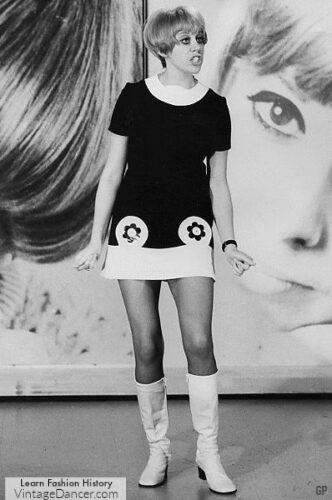
60s go go boots
In America, they became 1960s Go Go boots, named after a club in West Hollywood and the song “Going to a Go-Go.” At the club, the female disc jockeys danced and spun records while wearing a bra top, mini skirt, and flat pointy toe boots in a cage suspended above the dance floor. She was the Go Go dancer.
Almost any boots mid calf and above was called a Go Go boot. They were the American icon for all thing modern in fashion and morals.
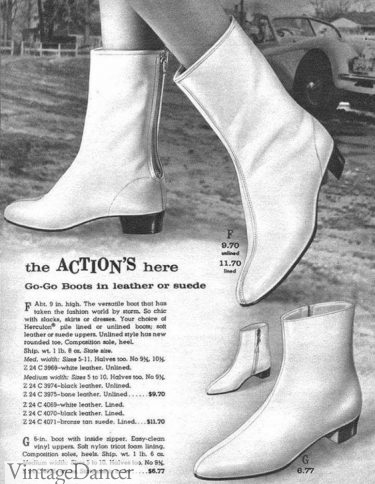
White Go Go half boots in leather or suede
The Cuissarde boot was an extreme version of the Go Go boot. Made of a shiny leather with an over the knee fit, it was modeled after eighteenth century soldiers’ riding boots, made to protect their legs during battle. The style represented any kind of swashbuckling man– musketeer, pirate, and Zorro.
When women wore Cuissarde boots paired with a mini dresses, they looked powerful. “Powerful” was a word not associated with women until now.
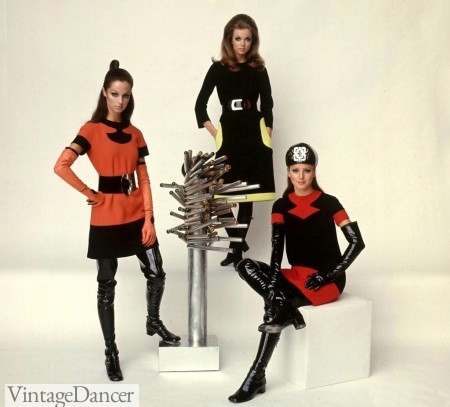
1966 Cuissarde Boots
Few women wore these ultra tall boots. Although not entirely uncomfortable, they were extreme and pretty hot to wear for more than an hour or so. High fashion, yes. Practical, certainly not.
The average woman wore half boots or calf height boots and still felt powerful in them.
1960s Winter Boots
Beside the bright and plastic look of go go boots women wore tall pull on boots in the fall and winter seasons. These were often in neutral colors such as brown, mustard, red or white. For extra warmth boots could be lined in faux fur and folded down to form a cuff around the calf.
Learn more about winter rain and snow boots.
- 1967 tall boots
- 1969 stretch boots
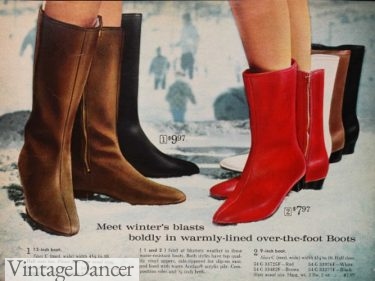
1967 snow boots
1960s Booties
1960s half boots were the first boot to cross into fashion.
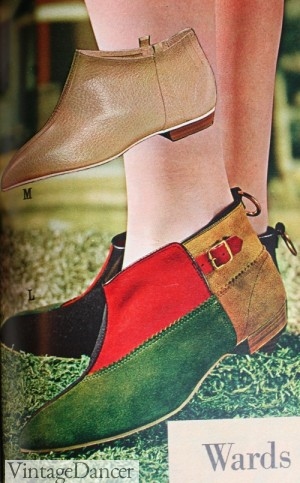
1964 Booties with Color Block Pattern
Half shoe, half boot, and loose enough to slip on, they were an entirely new design. They had the pointy toe and ultra low or flat heel like mainstream shoes, but came up to the top of the ankle. A little bow at the top or buckle across the front made them girly enough to be worn with skirts and dresses.
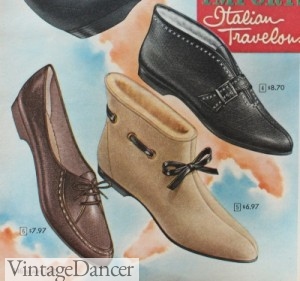
1961 Half Boots
For winter, many booties were lined in fur, sheepskin or flannel. The previous trend of showing off a fur lining at the top of the boot was too old fashioned.
Winter boots had to look like spring boots– nothing big or bulky would work for the Twiggy generation.
- 1966 suede booties
- 1964 Betta booties (Australia)
- 1969 buckle booties
- 1969 booties
Booties served a great service to the new fashion of stretch pants with stirrup feet. With flats, the stirrup was seen, which wasn’t a big deal until half boots came out. Suddenly, a visible stirrup was poor taste.
Half boots hid the stirrup yet were short and slender enough to still make shapely legs noticeable. In today’s fashion, leggings or skinny jeans paired with boots creates the same silhouette.
1960s Sneakers
Did women wear sneakers in the 1960s? Absolutely! Flat, casual sneakers in bright, fun colors were perfect to wear with dresses or jeans.
The classic flat sole sneaker — such as those from Keds, Skips, and Plimsoles — became the new school girl shoe. They had to be perfectly white and plain without fancy stitching.
Girls washed them with each load of laundry to keep them clean and pristine. They also wore them with white socks, and eventually tan stockings and tights.
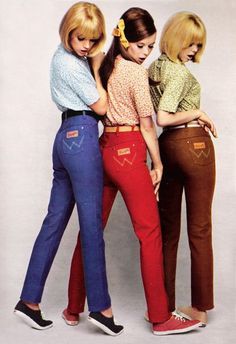
1967 Matching Wrangler Jeans with Sneakers
Women who had been wearing flat sneakers for years continued to wear them with pants, shorts and casual dresses. They came in more colors — both subtle and mod-ish — to match with every possible outfit. Men and children wore them, too, for an entire family of matching sneaker wearers.
- 1960 canvas flats
- 1962 canvas sneakers, flats, sandals
- 1964 Sneakers
- 1968 Jeepers sneakers
Converse sneakers also continued to be be sold in the 1960s as athletic shoes in black and white or all white high and low tops. They were not considered trendy or fashionable for most women to wear with anything but sportswear.
1960s Saddle Shoes
Black and white saddle shoes had been the casual shoe for girls, teens, and women since the late ’20s. Black and white shoes were still worn in the early ’60s, but became too old fashioned soon after.
Many school still required girls to wear saddle shoes with school uniforms or for P.E. classes. Newer “Italian” inspired saddle shoes were slimmer and flatter to match other shoe trends.
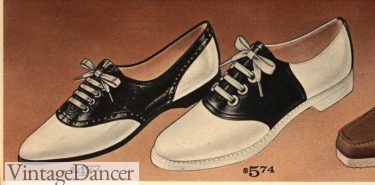
1964 bubble and classic saddle shoes
Read more about the history of saddle shoes.
1960s Hippie Shoes
The Birkenstock shoe, launched in 1774, was to become the shoe choice for long haired, folk wearing, activist hippies.
In 1964, the American distributor for Birkenstocks thought the rustic looking, single strap sandal with molded sole made of cork and leather would be appealing to the emerging hippies in Berkeley, California. She was right. It caught on like wildfire.
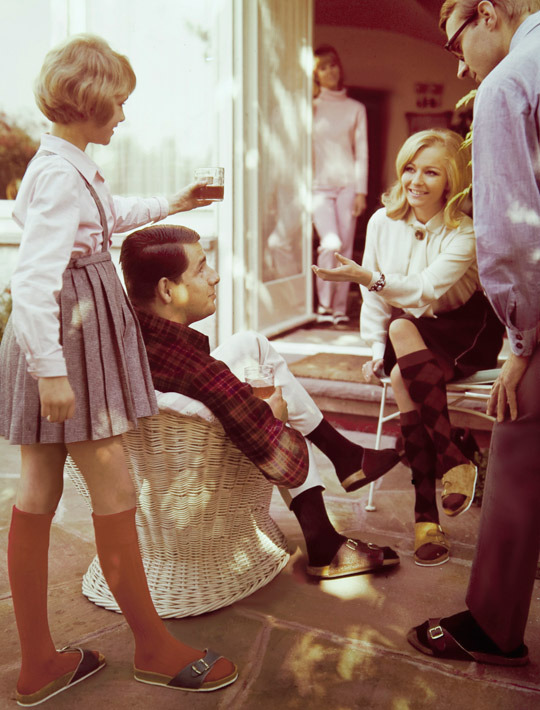
1968 Birkenstock Ad
Knock off designs followed Birks’ footsteps and expanded into the all leather and micro suede flat sandals.
Gladiator sandals were a favorite with Patty Boyd. Jesus sandals were also trendy, mostly with men but many women wore these style of sandal too.
With most hippie festivals and gatherings taking place in the hot summer sun a good pair of sandals was all they needed to wear.
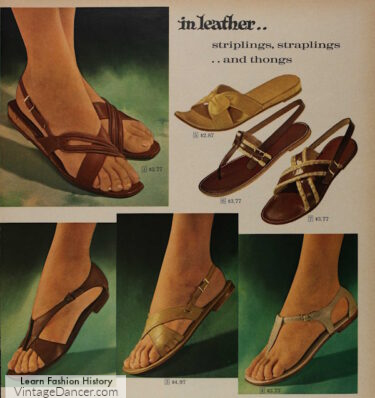
1966 leather sandals, perfect for earthy hippies
Moccasins with Native American influences were ideal hippie shoes. Loafers, slip-on casual shoes, half booties, and monk straps were all given a natural look in rough leather and suede.
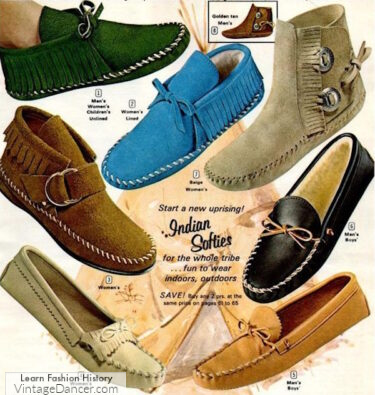
1969 moccasin shoes and boots,
1960s Orthopedic Shoes
For non hippies, another kind of comfort shoe was available. The idea of women needing more supportive, less pretty, shoes was on the rise. Specialty designed orthopedic shoes were worn for work or leisure.
The style featured a heavy body, thick sole, often wedge, with slip on loafer or moc toe top. The orthopedic shoe design has changed little from the 1960s to today. Today’s nurses shoes still resemble these original ’60s designs.
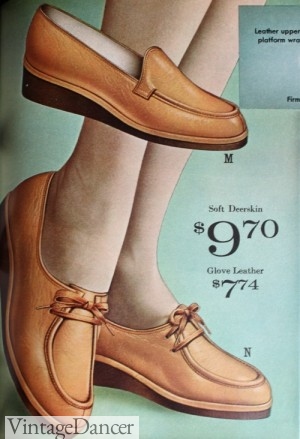
1964 Orthopedic Shoes
60s Sandals
Besides hippies, everyday women wore sandals in the 1960s. Flat and low heel sandals with wide or narrow straps and in fun colors made up most summer 1960s sandals.
Learn more about the history of sandals through the decades here.
- 1960 sandals
- 1969 sandals
1960s Style Shoes Today
After reading about 1960s shoe style and looking at the pictures, you may notice something. Don’t these look like shoes we wear today?
The current ’60s mod fashion revival has made many popular 1960s shoe styles come back around. Pointed toe flats? We wore those in 2013. Multi strap shoes? Those were big in 2014. Tall boots and half booties? Why yes, those have been trendy for a few years.
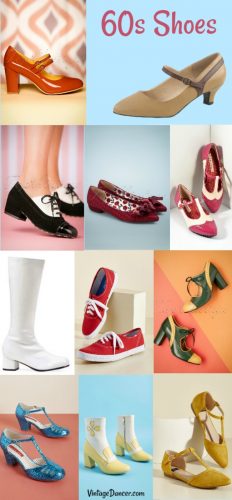
60s style boots, shoes, heels, flats. Shop here.
Finding a pair of 1960s style boots and shoes isn’t too difficult. Even finding vintage ’60s shoes isn’t an impossible task like pre-1950s styles are.
The only thing missing is the colors. Most shoes right now favor muted colors of the boho late ’60s early ’70s aesthetic. I miss the bright orange, yellow, teal, purple, and silver shoes that made the 1960s fun. I am sure they will come back around someday.
For now, enjoy browsing these 1960s style shoes for sale here.
Debbie Sessions has been teaching fashion history and helping people dress for vintage themed events since 2009. She has turned a hobby into VintageDancer.com with hundreds of well researched articles and hand picked links to vintage inspired clothing online. She aims to make dressing accurately (or not) an affordable option for all. Oh, and she dances too.
